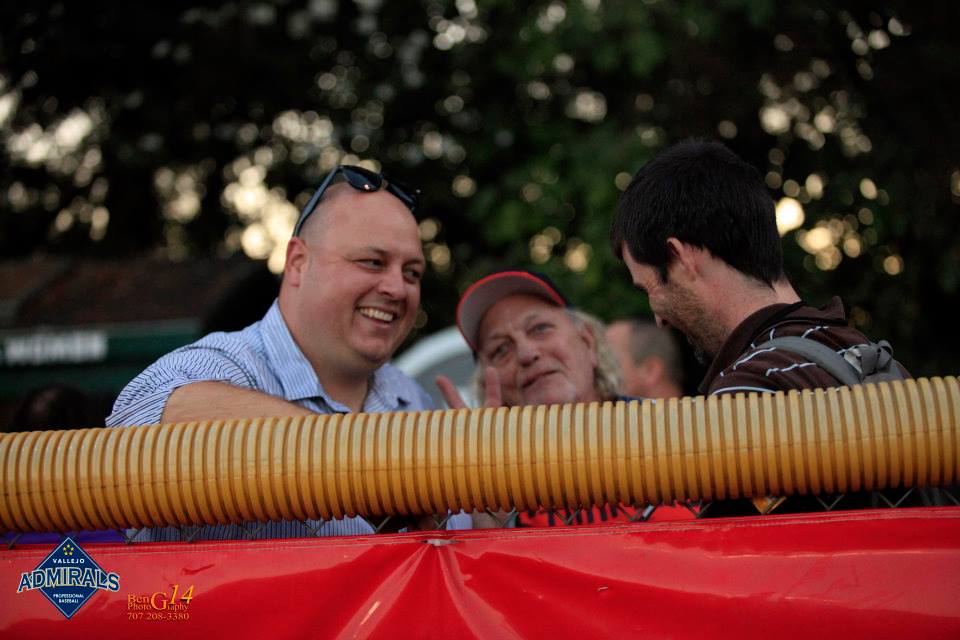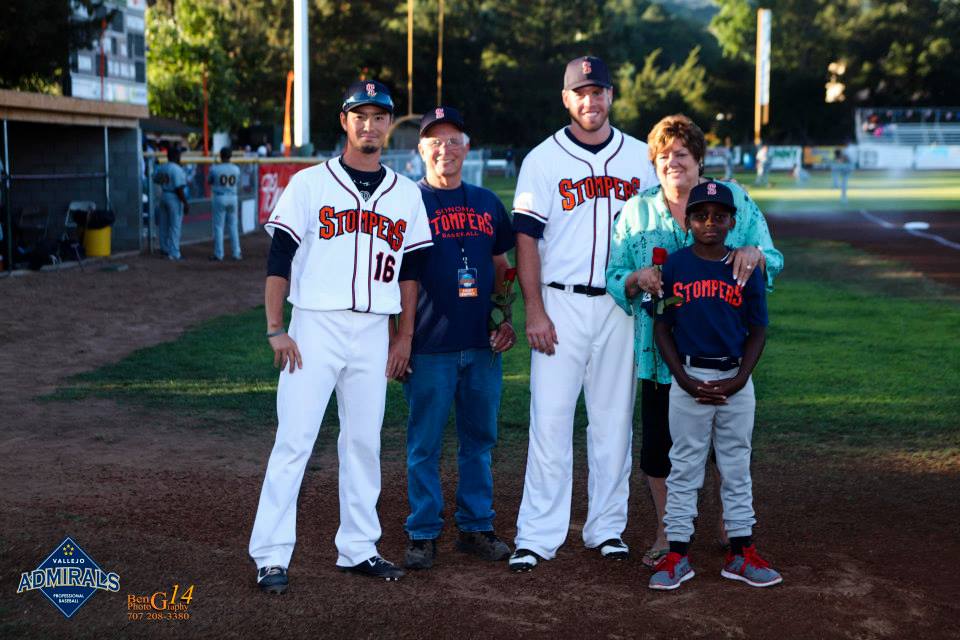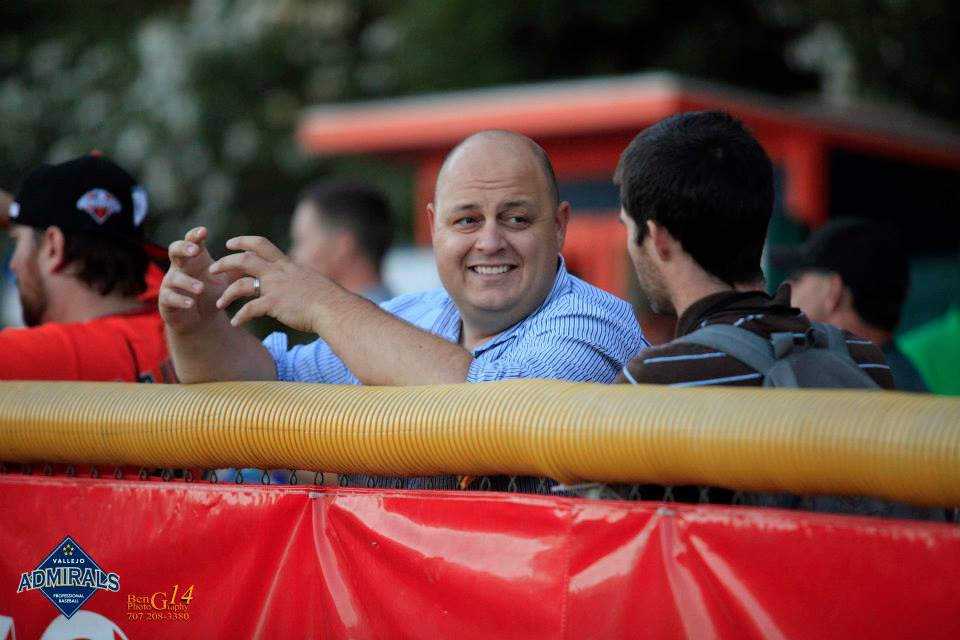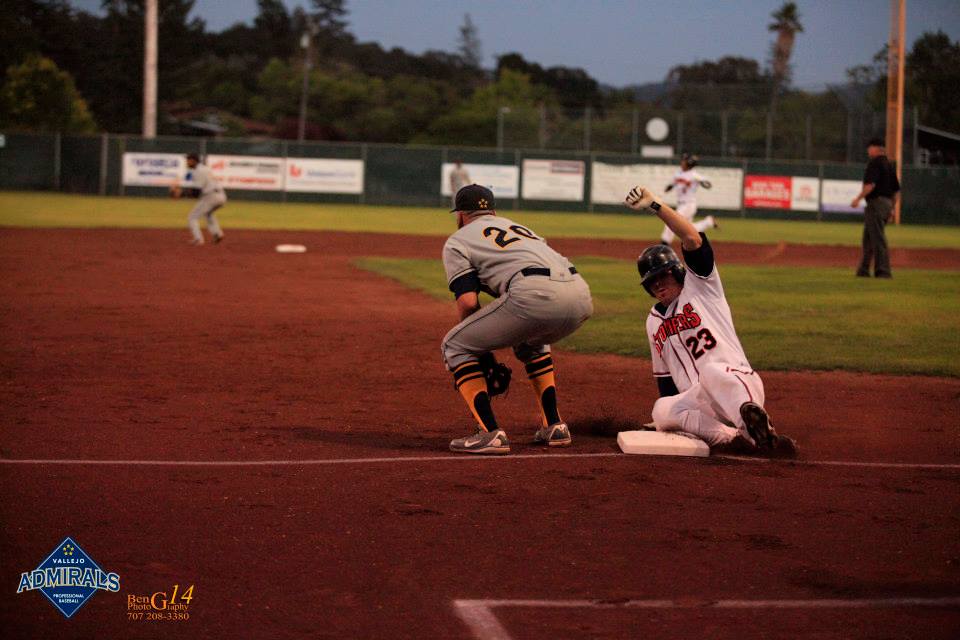In early August, an independent league team called the San Rafael Pacifics played a team from nearby Pittsburg, California, called the Mettle. The last-place Mettle are owned and coached by former big leaguer Wayne Franklin, who (at age 40) is also the team’s ace starter, sort of—he leads the league in innings pitched, by far, yet has the second worst ERA. (He rarely takes himself out. In his last start, he allowed 11 runs in a complete game.) In left field for the Pacifics was Eric Byrnes, the Eric Byrnes, out of retirement for two games to raise money for charity. Byrnes’ bat was slow and he had become a two-true-outcomes hitter, walks and strikeouts, but he sprinted all over the outfield, wandering far into F-8 territory because every ball he caught sent $500 to a veterans group. It all sounds like a lark, but anchoring the whole thing to reality was an honest pennant race.
The Pacifics were, at the time, a game up on the Sonoma Stompers and the Vallejo Admirals, a three-team battle in a four-team league. The Pacifics had won the first half, and if they won the second half they would win the league; otherwise, it would come down to a one-game championship game, like the one the Pacifics had lost last year. One of the guys on the Pacifics’ masthead put the team’s concern more directly: The Stompers, he told me, were the best of the three.
How does an independent team playing in its inaugural season, as the Stompers were, get so good? Two and a half weeks later, I drove up to Northern California's wine country for the Stompers’ final homestand, a crucial series against Vallejo. The general manager, Theo Fightmaster, let me follow him around. It was pretty great.

Fightmaster. Photo credit: Benjamin Gogna/Vallejo Admirals
***
It’s an hour before the game, and the Stompers are in their clubhouse listening to a pep talk from Dusty Baker, the marquee guest for tonight’s game. The clubhouse is directly below the center-field grandstand, a roughly 30-foot-by-30-foot dogleg that periodically squeezes a hot, sweaty gust of stank from its single door, a locker room’s fart. The crowd of players inside is too thick to hear what Dusty is saying, so a few of us with business at the park (an opposing coach, a freelance photographer, a batboy, awkward me) mill about outside, where the limitations of independent-league stardom are visible: The jerseys, freshly clean, hang from a chain-link fence for pickup. A few feet away is the club’s restroom, players only!

I bring up these details not to mock but to underscore the most important thing about roster-building at this level: There is very, very little money to go around. This affects every aspect of putting the team together, every aspect of the GM’s efforts to improve them in any way. For instance:
Since that game in San Rafael a couple weeks earlier, when I was told that Sonoma was the league's strongest team, the Stompers’ roster has undergone some changes. Their star catcher, Jaime Del Valle, a switch-hitter with speed who could also play second base—now there’s a profile—is gone. He had come to Sonoma midway through the season after falling victim to a clubhouse fracture in Vallejo, where he wasn’t playing regularly. Fightmaster put out a trade offer for him, then rescinded it; he got the sense that Del Valle was going to be released. When he was, Fightmaster swooped, and Del Valle produced a .363 OBP with seven steals. It was a huge exchange, like if the Royals decided to just release Sal Perez and the Tigers picked him up. The problem: Del Valle played too well. With three weeks of the season to go, the Evansville (Indiana) Otters purchased his contract.

Now, Evansville is an independent league team, too. But there is an unofficial league hierarchy in unaffiliated ball. Near the bottom, for instance, is the Pecos League, in the New Mexico region. The Stompers play a level up, in the Pacific Association, which is made up of the remnants of the North American League, which used to be the Golden Baseball League. Above them is the Frontier League, and maybe at the top is the Atlantic League, where the Sugar Land Skeeters play. The Skeeters famously employed Roger Clemens, Scott Kazmir, and Jason Lane in 2012. It’s not a coincidence they all played for one independent-league team: The Skeeters draw nearly 7,000 fans per game, more than almost every affiliated minor-league team. Vallejo, on a quiet night, might draw as few as 50.
Evansville is in the Frontier League, higher in the hierarchy than Sonoma. It pays more. It’s a step closer to playing in affiliated ball, which is Del Valle’s ultimate goal. The Stompers (who get compensated when they sell a contract to another team) left the decision up to him. He actually thought about it, but, with a mix of sadness and accomplishment, agreed. “Leagues like us exist to help guys move up,” Fightmaster says.
Del Valle left behind one final gift: Randy Consuegra, the starting pitcher tonight. Consuegra was from the same city in Colombia as Del Valle. Late in July—
Actually, here’s another thing about this league: Teams have to deal with visa problems constantly. The Stompers—
Ugh, okay, actually there’s another thing you should know to understand the visa problems. For their inaugural season, the Stompers hired a manager in his late 20s who had never played ball higher than high school. That’s very unusual, but this kid had managed a first-place team in the Pecos League and convinced the Stompers’ ownership (before Fightmaster had been hired) to make him the manager. It didn’t go great, and by the middle of spring training it was clear he wouldn’t be able to keep the clubhouse together. So he was let go. One of his ideas before that happened: Sign a bunch of guys with visa problems who were otherwise good enough to play in higher unaffiliated leagues. It was a pretty clever attempt at finding a market inefficiency, actually. A 140-pound pitcher named Gabriel Garcia was technically under the control of a team in a higher league (the American Association), but that team didn’t want to renew his visa. The Stompers were willing to try. Cool plan, except that they got a month and a half into the season and Garcia was leading the league in ERA and suddenly he was gone.
Same thing happened with their shortstop, actually. He was hitting .320. He’s playing in Germany now.
So the Stompers need a starting pitcher and Del Valle knows a guy, Consuegra. He’s a right-handed pitcher with a little sling in his motion, not a great body but some projection. He might be Edgar Renteria’s godson, it is said. He can throw. The Stompers knew none of this. None of it. They’d never seen him. But he offered to fly himself over from Venezuela and, lo and behold, he struck out 14 in his first start.
“We don’t have a vast network. It’s the allegory of the cave—looking at shadows and trying to make it out,” Fightmaster says. Each player on the roster has his own unusual transaction story, all of them surprising to the point that none is. Ray Serrano, now the manager, was a former catcher in the Braves system who had been starring for a now-defunct Hawaiian team. (He’s internet famous for a meltdown he once had upon being ejected from a minor-league game.) He and Fightmaster had a mutual friend who suggested Serrano as a veteran DH; they haggled for a week and a half over salary, Serrano signed, and almost immediately became the manager when the previous guy was fired. He has missed five games this year for suspensions after disputes with umpires. On this night, he’s also playing first base and spraying line drives around the field.
Serrano had a Baseball-Reference page, so it was easy for the Stompers to put faith in him, but the Affiliated stamp doesn’t guarantee anything. Fightmaster has learned in this job that, for guys at this level, opportunity is half chance. A kid who played for the right scout on the right day might have been drafted, but it doesn’t mean he’s better than guys who never got a shot. The Stompers’ best player is a local kid named Jayce Ray. He was a starting outfielder for the University of Washington but suffered a shoulder injury—to his non-throwing arm—and big-league clubs lost interest. So he played for Windy City in the Frontier League last year, and the Stompers traded for his rights to bring him home for his age-24 season. He’s probably the MVP of the league, playing center field and leading the circuit in outfield assists, top-three in every hitting category. “No one’s keeping track of WAR in this league but it’s probably 7 or 8,” Fightmaster says. “And he’s never gotten a sniff.”
And then there are the guys who don’t turn into stars but find a role. Gary Stauff, 27, was brought out in the spring because, basically, you need three catchers to run a training camp, or else there aren’t enough targets for pitchers to throw to. The plan was to cut him loose after 10 days, which sounds like a pretty cruel plan: Guys don’t get paid for training camp, and Stauff had come all the way out from the midwest. When the old manager was let go—the one with the 10-days-and-cut-him plan—Stauff was suddenly useful, so he stayed on to be the bullpen coach, lead strength and conditioning, coach third base. With Del Valle gone, he’s suddenly become the backup catcher, too. He turned out to be useful to the Stompers; the Stompers turned out to be useful to him.
Starting pitcher Consuegra is, admittedly, an extreme example of blind scouting, and it’s not a method Fightmaster is totally comfortable with. He thinks about what it would have been like if Consuegra had flown all the way over here and had a straight 76 mph fastball. They couldn’t have let him start; they couldn’t have let him relieve, even. In that case, Fightmaster would have felt a) bad and b) a responsibility to the kid, to find him a spot on some team somewhere. If he wanted to, and if he didn't mind feeling bad, he could get a near-infinite supply of Randy Consuegra wannabes. Guys will quit jobs and leave girlfriends behind to fly across the country (or from another country) on the off chance they can get a roster spot that pays a few hundred dollars a month.
“I can get 100 guys out here a month for tryouts, easy,” Fightmaster says. “As a person, I don’t feel comfortable doing that.” The team did have one open tryout in the spring, which yielded Matt Marquis, a former Red Sox farmhand who flew out from Jersey. But even for that, the club charges $100 per registrant, partly to discourage people from trying out. (Also partly because revenue is otherwise hard to generate in April.)
Even when Fightmaster doesn't invite them, they come. One day in spring training, Fightmaster showed up to the field for workouts. There was a Japanese kid, two suitcases, street clothes, digging into the post-workout spread. “I Yuki,” he told Fightmaster. “I play baseball.”
Yuki Sakama, a few days earlier, had apparently seen on Facebook that some former teammates had joined an expansion team in Sonoma. The 26-year-old flew into San Francisco from somewhere in the Midwest, took a $100 cab ride to Sonoma, and showed up at the park. “Yuki!” said the new manager Serrano, who had apparently played with or against him sometime in their past. “WTF are you doing here?” Yuki’s left-handed, and he’s got this freaky drop-down motion that seems like it would be hell to pick up the first dozen times you see him. Fightmaster asked Serrano, can we use him? ”Yeah, we can use him.” Fightmaster asked, does he know there’s no money? Serrano told Yuki, “Here—no money. $400, $500 a month.” Yuki smiled, Yuki nodded, Yuki Yuki, Yuki play baseball. Yuki’s the closer now. When he gets the last out of an inning, he screams and stomps back to the dugout like it's Game Six of the World Series.

Yuki, on the left, with his host "father." "They asked if we could put somebody up for 10 days." Another host family jumps into the conversation: "They told us it would only be three days!" Photo credit: Benjamin Gogna.
***
It’s the Stompers’ biggest pre-sale attendance of the year, thanks to Dusty Baker, who is standing about 15 feet away from me and Theo, signing autographs. His seats are in a roped-off area, the Cline Cellars Club, down the third-base line, offering protection from fans holding giveaway photos of Baker and clamoring for autographs. But as Fightmaster had walked him toward his seats, Dusty had stopped to get a hat and a t-shirt for his son, and the 90-second delay would cost him a half hour. A crowd surrounds him: He high-fives a mascot. He reminisces about Arcadia with a girl from Arcadia. (“Arcadia has the best Army-Navy surplus store,” he says, like hell he says that, but really, he does.) He signs a girl’s iPhone. “Yeah man,” a weirdo on a cell phone says loudly, “I’m standing here five feet away from Dusty Baker.” Geez, dude, be cool.
Fightmaster had gone to Baker’s summer baseball camp back around 1991, when Baker was still just the Giants' hitting coach and had time to go to the camp five days a week. It was Fightmaster’s first sleepaway camp, and he liked it so much that he kept going until eventually he was a counselor and he had something like a friendship with Baker. After the camp, he played in high school (above-average), then some juco ball (below-average), then a failed walk-on attempt at Arizona State (he played intrasquad games against Dustin Pedroia). He’s a big guy, a build like Kendrys Morales, but with an all-glove no-pop game that doesn't shine at first base.
So his career ends, basically. He wants to stay involved in the game, gets a couple internships with the Milwaukee Brewers’ ticketing and marketing department, but it’s a steel curtain between business and baseball ops, so he knows he’s not going anywhere with them. He coached some high school (“Anything to stay in the game”) and played some fantasy baseball (“Unsuccessful. Too busy”) and wrote sports stories for a few local media outlets, including the Marin Independent. While there, he wrote an article about the guy who was bringing baseball to San Rafael. The guy—this sounds weird, but it happened—offered him the equivalent of an assistant GM job with the Pacifics. So he took it. “I just figured I couldn’t turn down a job around baseball. A job in baseball is all I ever wanted.” This year, he moved from San Rafael to Sonoma for the Stompers’ inaugural season.

***
If it was a steel curtain in Milwaukee between business (where he didn’t care to be) and baseball (where he did), it’s more like a two-person sleeping bag at this level. Fightmaster generally watches about two or three innings per game, and the rest of the time he’s changing out a keg, dealing with neighbors complaining about the noise, or in his office doing paperwork. (In our four hours together, I watch him wander off to pick up litter; advise a vendor not to accept American Express; scold some kids who are pushing a gate to the field open; scramble to find somebody to throw out the first pitch; arrange for a beer to be sent to Dusty Baker (“Oooooh, Lagunitas,” Baker says); and cut off ticket sales for the packed grandstand behind home plate. At one point, the start of an inning is delayed, and Fightmaster, alarmed, moves toward the field. Turns out that the Vallejo third basemen was just taking a leak. “I thought we were out of balls, which really scared me,” Fightmaster says.)
So we watch the game, but Fightmaster watches the game unlike anybody else at the park. For instance, he watches the game with an eye on his watch. Fourteen of his staff are paid by the hour, which means “after 2 1/2 hours we’re losing money.” (Which puts the Atlantic League's radical speed-up-the-game changes in the proper context.) Money is just constantly part of the equation. He talks to the opposing team’s photographer about budgets, about how Vallejo staff lost food privileges midseason. Food privileges can be expensive. A visiting manager once asked Fightmaster for a free hot dog. Fightmaster had to turn him down.
He seldom responds to the action on the field, and usually only in one-word frustrations: “Geez,” usually. When the third-base coach, Stauff, holds the potential tying run in the fourth, I ask whether Stauff should have sent the runner home. Theo pauses. “No,” he tells me. It’s the only time all night I suspect he’s not telling me the whole truth.

He does want to win, and a bad loss can eat at him, but he wants to win primarily because the players want to win, and he wants them to get what they want. He loves them. He wants them to win, and then he wants every single one of them to get poached by a better team than his. There’s not one guy he doesn’t want back next season, but there’s not one guy he doesn’t want to lose, too.
As far as his own incentives—winning barely registers. More than half his job in unconcerned with wins and losses; it cares that the players are well behaved and that the fans want to come back. “The owners’ objective is basically this vision of a family of four leaving the game, the kids got to high-five the mascot, they got a foul ball, they’re walking to their car and saying, “What a fantastic night at the park. By the way, who won?” More than half his job doesn’t view these as ballgames but as events, as Dusty Baker delivery systems. The best free agent he signed this year wasn’t Jaime Del Valle or Jayce Ray or Ray Serrano; it was the $10,000 mascot costume that he scored for free from a defunct local hockey team.
That tying run that Stauff held up at third never does score. Then Vallejo adds a couple runs against the bullpen, and the Stompers can’t put three hits together, and nobody in the stands that night knows it but Sonoma will finish 3-5 and the Pacifics will finish 6-2 to win the title, no one-game playoff needed. Nobody in the stands knows it but Consuegra hurt himself earlier in the game, and there’s no medical insurance and no disabled list at this level, so who knows what that means for the guy who flew himself out here with nothing but another guy vouching for him. They don't know whether Vallejo and Pittsburg will be back in the league next year, or whether the league will be back next year, and if it is they don't know whether Serrano or Ray or Stauff or anybody else on the team will be back next year. Right now, on this cool summer evening, they know only that they’re with friends, in their own community, watching baseball with the lowest stakes possible and, simultaneously, baseball that will break hearts and make careers.
“We’re gonna rally,” Fightmaster tells one of the regulars in the seventh inning, trailing by two.
“Oh, are you?” the guy asks.
Fightmaster thinks it over. “I think so.”
The guy stares at him for a long pause, then realizes—oh, the baseball game. “Ha, I thought you meant at the bar tonight."
Thank you for reading
This is a free article. If you enjoyed it, consider subscribing to Baseball Prospectus. Subscriptions support ongoing public baseball research and analysis in an increasingly proprietary environment.
Subscribe now
I would read a series that just followed a minor league front-office guy around for a week. Or a European GM! What's life like in the Austrian Baseball League?
(And kudos to Evansville for letting Jon Bois design their webpage.)
Great piece.
In his first start, he walked the first four batters (throwing four wild pitches along the way) and hit the fifth before getting pulled from the game.
Five days later (against the same team), he threw four very wild balls to the first batter, got one groundout, and then walked or hit the next six batters straight. It was the most painful baseball experience I've ever seen.
That second start, in which he gave up seven earned runs in 0.1 innings, "lowered" his season ERA to 270.00 (from infinity). He never threw another pitch in affiliated baseball.
Great stuff as usual, Sam.